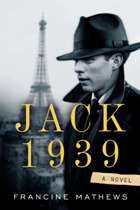Borrowing From the Dead
By Francine Mathews
A long time ago, before I was a journalist or an intelligence analyst or the mother of two boys, I was a graduate student in History atStanfordUniversity. As part of the ordeal that was my third year, I was expected to do nothing but Read for Orals. This is a hoop through which every grad student must jump—seven or eight months of sitting in the deep chairs of a campus library, staring blindly at texts, preparing to answer any question a panel of experts might pose. I gave up somewhere in month two and read Dorothy Sayers instead.
I discovered, however, that I love history not for the statistics or the dates or the succession of events it records—but for the characters that it brings to life. Lives of glamour or suffering; lives of crazy triumph. Lives of utter evil, unredeemed by a plot twist at the close. Lives, maybe, like yours and mine…except for that fact that they’re over and done with. History.
I began to look at the Dead through a different lens. They’re all characters, waiting to be used, their remarkable lives better than fiction. History is written by the victors, of course; which is another way of saying that history is a fabrication, an interpretation, a riff on what might have happened…or the basis for a novel. Where would Hilary Mantel be without Thomas Cromwell? Or Philippa Gregory without that Other Boleyn Girl?
I’ve written twenty-two books over the past two decades, half of them about Jane Austen. I’ve taken liberties with Virginia Woolf and Allen Dulles and Queen Victoria, and none of them has complained. My latest—JACK 1939, which follows a college kid named Jack Kennedy through Europe as it teeters on the brink of war—feels like the most audacious borrowing I’ve done yet. But these books work because they begin with a plausible what-if: a moment of doubt in the official record, a gap in what is known. Virginia Woolf goes for a walk on March 28, 1941, with a dubious note propped on her mantelpiece; but her body isn’t pulled from the Stour until twenty days later. What if she boarded a train that March afternoon, instead of killing herself? What happened during the subsequent three weeks—and why did she end up in the river?
Now that’s an interesting story. I called it The White Garden.
For these parallel universes to feel plausible, however —for the true suspension of disbelief—I think it’s essential to hew as much as possible to fact. When I start to mold history, I first want to know the facts. If I’m seized by a what-if, seduced by its novelistic possibilities, I immerse myself in research until I’ve educated myself on the subject. Take JACK 1939, for example.
The facts: Jack Kennedy skipped the spring semester of his Harvard junior year to research his senior thesis. He traveled alone for six months through Europe as Hitler was mobilizing to invadePoland. He interviewed anybody official, Nazi or otherwise, who could understand English or his execrable French. He was inLondon,Paris, Val d’Isère, Danzig,Prague,Munich,Berlin,Warsaw,Latvia,Moscow. We know roughly when he was there from the letters archived in the Kennedy Library.
The fiction: Jack, the son of theUS ambassador toEngland, is tapped by Franklin Roosevelt to act as a spy while he travels through Europe—because the Nazis are trying to buy the 1940 election for Wendell Wilkie andRoosevelt has absolutely no intelligence service.
It’s the architecture of the plot that marries fact with fiction. I set myself parameters when I’m working with a real life: If I place Jack inMoscow, it must be roughly when he was actually there; but his documented trip toJerusalemfit nowhere in my plot, and was therefore elided. Yes, I give him guns and secret codes and a bombshell sidekick, but I strive to be true to my sense of who Jack was as a young man—which is somewhat different from the President he became. In researching young Jack, I’m struck by his chronic and severe illness; by the weeks he spent in hospitals as a kid; by the loneliness of confronting mortality at a young age; by the incessant reading his isolation and boredom encouraged. If you’re going to borrow a character from the Dead, you have to make him your own. My Jack is analytic, yearning, desperate for connection but fearful of loss; a boy who uses his charm and his smile to keep the world at arm’s length.
In the end, it’s the characters we follow—they act as our guides in how to live. It’s the characters who keep me writing.
That, and a History habit I just can’t kick.
 Francine Mathews also writes as Stephanie Barron.
Francine Mathews also writes as Stephanie Barron.


